TL;DR
Expect darker blues, weathered grays, warm wood tones, and black-framed windows to lead 2025 exterior design trends. Use a home design AI like ReimagineHome.ai to test siding colors, mixed materials, and landscaping in minutes—especially if you’re asking the long-tail question: how do I choose the best exterior color palette for my house style and climate?
2025 exterior design at a glance
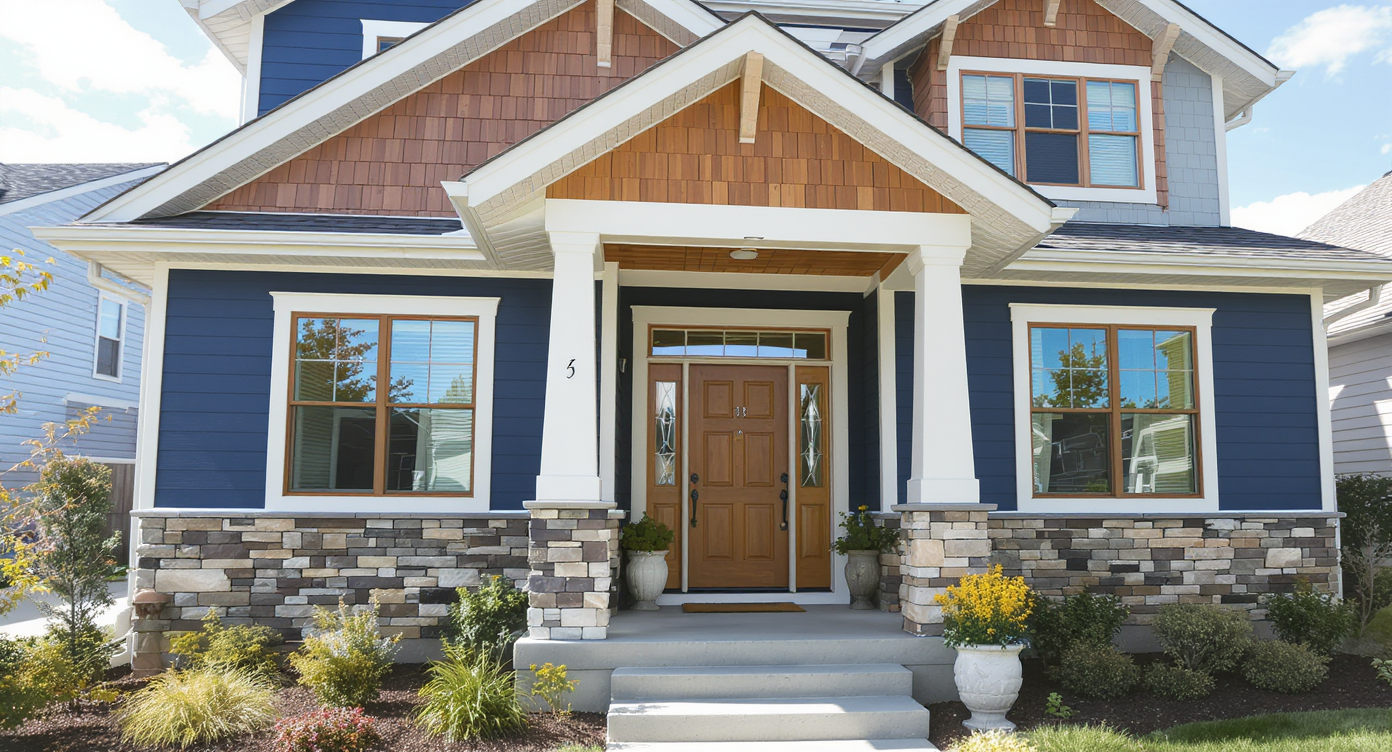
Explore 2025 exterior styles blending rich colors, warm woods, and smart details for welcoming curb appeal.
SEO intro: See 2025 exterior design trends—colors, materials, windows—and use ReimagineHome.ai to preview your home’s facade before you buy.
The exterior design story in 2025 is richer and more grounded: darker blues and weathered grays, off-white trims, warm wood tones, and mixed textures that feel custom without the maintenance headache. Homeowners are pairing clapboard and shakes, adding stone wainscoting, and choosing black-on-black or bronze-on-bronze windows for a refined, modern edge.
Here’s the thing: none of this is one-size-fits-all. Light levels, neighborhood context, regional weather, and even roof color change how your palette reads outdoors. That’s where visual tools like ReimagineHome.ai shine. Upload a photo, test siding colors, swap profiles, layer stone, and even mock up landscaping—an ai interior design mindset applied to your whole exterior. A 10-minute AI preview can save weeks of second-guessing.
Suggested image caption: Weathered gray clapboard with warm wood-tone accents and black-framed windows. Alt text: modern exterior with gray siding, cedar-look soffit, black windows.
The core strategy: a simple 5-step plan you can visualize with AI
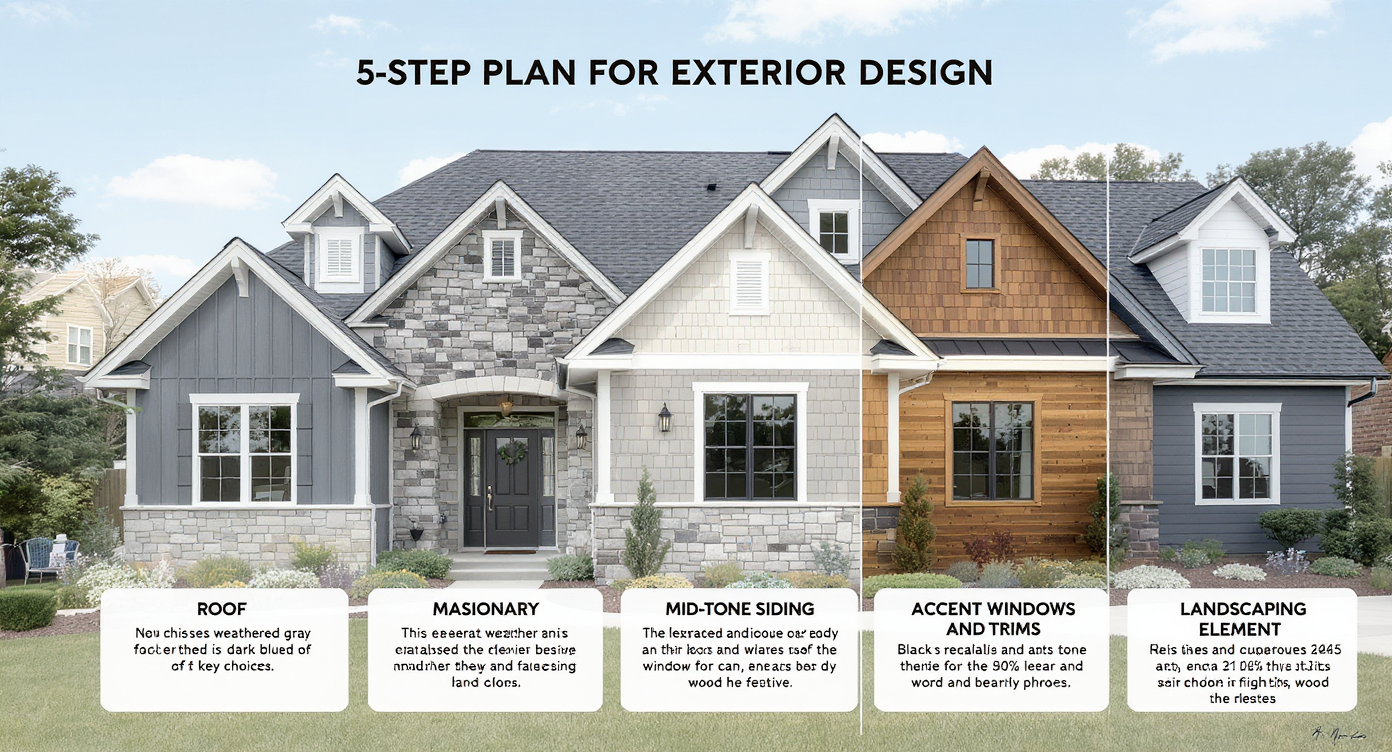
Visualize the 5-step exterior design plan with realistic textures and 2025 color palettes for confident choices.
Answer in one sentence
Start with your fixed elements (roof, masonry), select a mid-tone field color (LRV 20–45), add a softer trim (LRV 70–85), introduce one texture accent, then verify daylight contrast using a home design AI before you buy a single gallon.
- Audit what won’t change. Roofs, brick, driveways, and large trees dictate undertones; pull 2–3 color chips that echo those fixed hues rather than fight them. Experts recommend sampling against the roof in full sun and shade for at least 48 hours.
- Pick your field color (the siding). 2025 palettes lean into darker blues, weathered grays, olive, and clay—elegant but livable. A practical rule: look for a Light Reflectance Value between 20 and 45 to avoid glare while keeping depth.
- Soften with trim and accents. Off-whites (cream, linen, warm gray) are replacing stark bright white; 3.5–5.5 inch trim widths frame windows cleanly without looking bulky on most homes.
- Mix one material for texture. Wood-tone aluminum or vinyl accents, stone wainscot at 30–36 inches, or shakes in the gable add dimension without overwhelming. Limiting accents to 10–20% of the facade keeps the look cohesive.
- Specify windows and doors. Black-on-black and bronze-on-bronze vinyl windows remain strong; in mixed palettes, bronze softens contrast. Aim for U-factor ≤ 0.30 in cold climates and SHGC 0.25–0.40 in hot-sunny regions.
- Light and landscape to finish. Use 2700–3000K exterior LEDs for warm, evening curb appeal, and keep main walkways 42–48 inches wide for comfortable, universal access.
- Preview with AI before you commit. In ReimagineHome.ai, test two close-in-tone palettes (e.g., Aged Gray vs. Flagstone) plus one wild card, swap in V-groove vs. wide-plank profiles, and toggle black vs. bronze windows to see what really lands.
Suggested image caption: Side-by-side AI mockups comparing gray vs. blue siding with bronze windows. Alt text: AI exterior design comparison with two color schemes.
User insight: Homeowners who preview three palettes with a home design AI report deciding 2–3 times faster because they can see materials together in real daylight.
Anecdote
Visualization scenario: Imagine uploading your facade to an AI room designer for exteriors. You toggle weathered gray clapboard, add a 34-inch stone base, and switch windows from black to bronze. One click later, the entry warms up, the roof feels integrated, and the whole house finally looks like it belongs on your street—proof that a few coordinated moves beat a dozen disconnected ones.
Common mistakes homeowners make (and how to avoid them)

Avoid common exterior mistakes by testing undertones and contrast before committing to your palette.
Answer in one sentence
Most exterior regrets come from ignoring undertones, over-contrasting trim, adding too many textures, undersizing lighting, or skipping real-world samples.
- Going too stark with trim. Pure white can look harsh outdoors; choose a warm off-white that’s 30–40 LRV points lighter than the field color for balanced contrast.
- Texture overload. Field siding + shakes + stone + wood + metal is too much; cap accents at two materials beyond your main siding.
- No sample boards. Paint three 24×24 inch boards or order sample panels and view them morning, noon, and dusk; colors shift 1–2 shades in natural light.
- Lighting as an afterthought. Undersized sconces disappear; as a rule, fixtures should be 1/4 to 1/3 the height of the door and mounted at 66–72 inches.
- Forgetting climate. Darker colors can run hotter; in intense sun, pair deeper hues with high-quality, low-fade cladding and ventilated rain screens where appropriate.
Pro tips from designers and installers

Designers advise focusing on one statement feature and using AI previews for flawless results.
Answer in one sentence
Designers recommend editing ruthlessly—one statement move, impeccable proportions, and details that stand up to 10 feet and 100 feet away.
- Lead with proportion. Wide-plank clapboard (6–8 inch reveal) reads modern without trend-chasing, while V-groove profiles add crisp shadow lines on larger elevations.
- Mind the overhangs. A 12–24 inch eave overhang protects siding and creates pleasing shadow; it’s functional resilience that also looks deliberate.
- Use color temperature like a dimmer. Warm wood-tone accents near entries humanize darker palettes; match grain direction to sightlines to feel intentional.
- Future-proof the windows. Black frames are timeless when the grid pattern aligns with architecture; fewer, larger panes feel contemporary and simplify cleaning.
- Stage the yard like a room. A simple bed line, one specimen tree, and layered plant heights (12–24–36 inches) create depth without clutter—easy to mock up with ai landscape design tools.
Suggested image caption: V-groove siding with warm-toned soffit and stone base, evening lighting at 3000K. Alt text: contemporary facade with layered materials at dusk.
Real stories: small choices, big curb appeal

Small design choices can create powerful curb appeal without overwhelming the facade.
Answer in one sentence
Small, strategic changes—often under 20% of the facade—can deliver most of the perceived transformation.
A starter home, transformed by restraint. A couple swapped harsh bright white trim for a creamy off-white and added a 32-inch band of stone at the base; the house looked taller and warmer without touching the roof or porch.
The window color pivot. A homeowner dead set on black frames previewed bronze in ReimagineHome.ai and realized bronze softened the contrast against olive siding—same budget, better harmony.
Texture where it counts. A townhome facade used wide-plank clapboard on the main field with wood-tone metal on the entry bump-out; keeping texture to 15% of the elevation made the accent feel custom, not busy.
Landscape as the exclamation point. A 48-inch walkway, low-voltage path lights, and a single multi-stem tree reframed a modest ranch—proof that curb appeal isn’t only about siding.
Visualization Scenario
- Tools to try: ReimagineHome.ai (photo to home design), ai landscape generator for planting beds, virtual staging real estate free trials for listing-ready images.
- Alt text suggestion bank: “modern exterior with dark blue siding and bronze windows,” “wide-plank clapboard with stone wainscoting,” “evening facade lighting 3000K.”
Call to action: Ready to redesign your exterior with confidence? Upload a photo to ReimagineHome.ai and test colors, profiles, windows, stone, lighting, and landscaping—before you buy.
FAQ: quick, snippet-ready answers
How should I choose a 2025 exterior color palette for my house?
Match undertones to fixed elements (roof, brick), pick a mid-tone field color (LRV 20–45), and a warm off-white trim 30–40 LRV points lighter; confirm with an AI preview and large samples.
What’s the best way to mix siding, stone, and wood without looking busy?
Limit yourself to one field material plus one accent (stone or wood) covering 10–20% of the facade, and keep a consistent undertone across all finishes.
Should I choose black or bronze windows for a modern look?
Black is bold and graphic; bronze offers a softer, upscale contrast—both pair well with darker blues and grays, so test each against your siding in natural light.
How can AI help me redesign my exterior or backyard?
Use a home design AI like ReimagineHome.ai to try siding colors, window finishes, stone heights, and ai backyard design in photo-real views before you spend.
What lighting specs improve nighttime curb appeal?
Choose 2700–3000K LEDs, size sconces to 1/4–1/3 of the door height, and keep mounts around 66–72 inches for balanced illumination and safety.
Make 2025 your year of confident curb appeal
2025 exterior design trends reward clarity: richer color, refined profiles, and honest texture—edited, not excessive. If you’re torn between two palettes or profiles, don’t guess. Upload a photo to ReimagineHome.ai, try a few mixes, and make the decision with your eyes, not your imagination.
When you can see the whole composition—color, siding profile, stone height, window finish, lights, and plants—confidence follows. That’s the quiet luxury of great curb appeal.
.svg)

.svg)

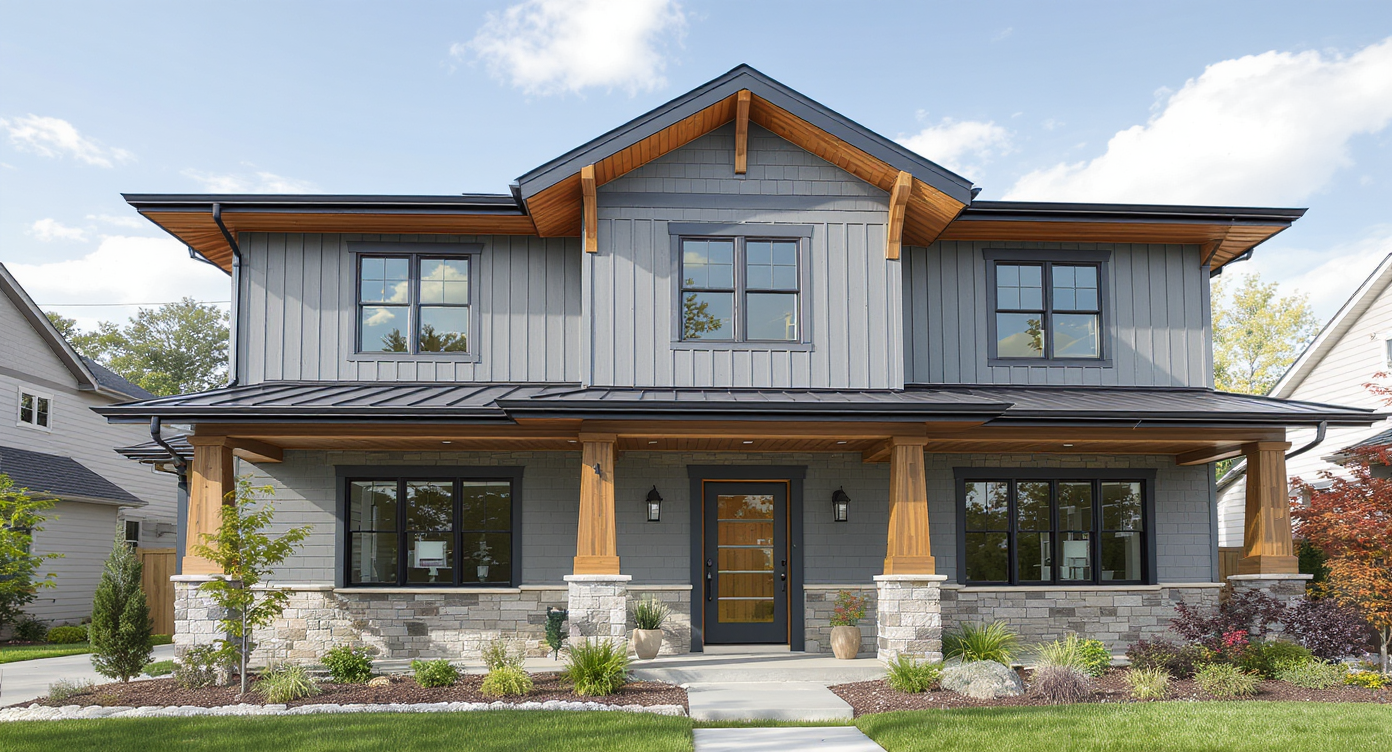





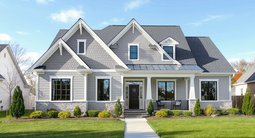


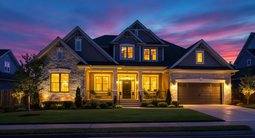
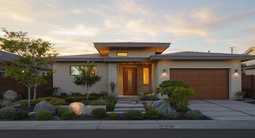


.png)